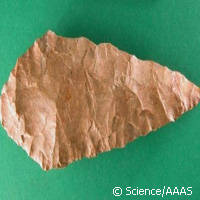Study finds prehistoric people were highly skilled toolmakers
Modern humans had a sophisticated repertoire of tool-making techniques much earlier than was previously believed, new research shows. The study was funded in part by the TRACSYMBOLS ('Tracing the evolution of symbolically mediated behaviours within variable environments in Europe and southern Africa') project, which secured a European Research Council (ERC) Advanced Grant worth EUR 2.5 million under the Seventh Framework Programme (FP7). The findings were recently published in the journal Science. The scientists discovered that a highly skilful and delicate method of sharpening and retouching stone artefacts by prehistoric people was developed at least 75,000 years ago, more than 50,000 years earlier than previously thought. They found that the technique, known as pressure flaking, emerged at Blombos Cave in South Africa during the Middle Stone Age by anatomically modern humans. The process involved the heating of silcrete - quartz grains cemented by silica - used to make tools. Prior to this discovery, the earliest evidence of pressure flaking was from the Upper Paleolithic Solutrean culture in France and Spain roughly 20,000 years ago. Pressure flaking occurs when implements previously shaped by hard stone hammer strikes followed by softer strikes with wood or bone hammers are carefully trimmed on the edges by directly pressing the point of a tool made of bone on the stone artefact. Thanks to this technique, the sharpness, thickness and overall shape of bifacial tools like spearheads and stone knives are controlled better, according to Paola Villa, a curator at the University of Colorado Museum of Natural History in the US and a co-author of the study. 'This finding is important because it shows that modern humans in South Africa had a sophisticated repertoire of tool-making techniques at a very early time,' Dr Villa said. 'This innovation is a clear example of a tendency to develop new functional ideas and techniques widely viewed as symptomatic of advanced, or modern, behaviour,' she added. 'Using the pressure flaking technique allowed toolmakers to exert a high degree of control on the final shape and thinness... [that] helped to produce narrower and sharper tool tips.' The bifacial points, known as Still Bay points, were probably spearheads. With the exception of obsidian, jasper and some high-quality flint, few stone materials can be pressure flaked without first heating them, Dr Villa pointed out. While there is evidence of silcrete heating some 164,000 years ago at the Pinnacle Point site in South Africa, the Blombos Cave artefacts are the first clear evidence of the skilful pressure flaking technique used to carefully shape, refine and retouch tools, she explained. There are several ways to confirm whether silcrete has been heat-treated, Dr Villa said. Archaeologists at Pinnacle Point in South Africa used two common methods called thermoluminescence and archaeomagnetism that require the destruction of stone tool samples, as well as a non-destructive technique known as maximum gloss analysis. The team working on the Blombos Cave artefact used a visual method for the analysis based on the contrast between heated and unheated tool surfaces observed microscopically at low magnification. While the removal of flakes from unheated silcrete produces scar surfaces with a rough and dull texture, heat-treated silcrete scar surfaces have a smooth, glossy appearance, Dr Villa said. 'Pressure flaking adds to the repertoire of technological advances during the Still Bay (period) and helps define it as a time when novel ideas were rapidly introduced,' the authors wrote. 'This flexible approach to technology may have conferred an advantage to the groups of Homo sapiens who migrated out of Africa about 60,000 years ago.' Experts from France and Norway contributed to this study.
Countries
France, Norway, United States, South Africa



